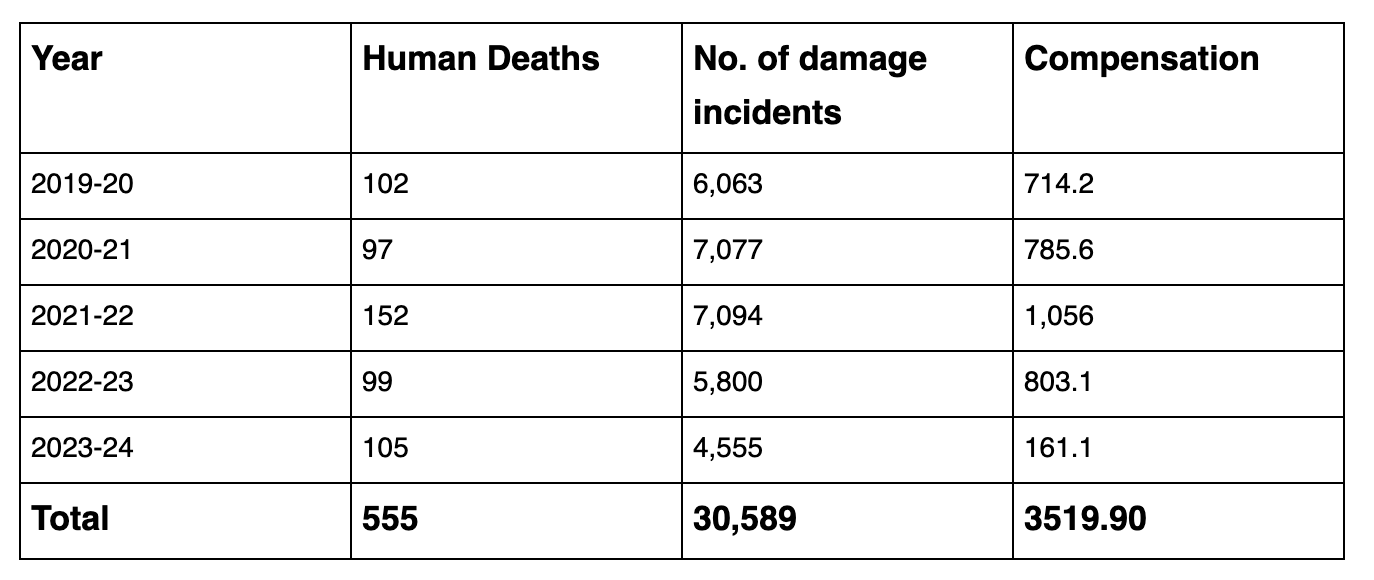Collapse of the ecological balance and an undeclared war with nature
Relevance: GS Paper III
Why in News?
Two recently occurred incidents in Wayanad, Kerala, a wild elephant killing a 47-year-old farmer and an elephant herd attacking an ecotourism guide at Kuruvadweep Islands, have sparked protests, strikes, and a political slugfest.
|
Ecological Balance:
Significance Of Ecological Balance:
Data shows rising human-wildlife conflict in Kerala -  |
Habitat fragmentation:
- A study report titled Right of Passage: Elephant Corridors of India conducted by the Wildlife Trust of India identified 88 elephant corridors in 2005, with 24% of them under reserve forest and 76% under forest, agriculture, tea gardens, and human settlements.
- Fast forward 20 years, the data shows reduced corridors for wildlife, leading to the confinement of wildlife to fragmented forests, forcing their raids to surrounding areas.
Case study - Wayanad, Kerala:
- In Wayanad, the official data has documented 51 human deaths due to wildlife attacks during the last 10 years, which surged to 98 fatalities, encompassing 8,873 attack incidents in the fiscal year 2022-23, with 27 of those deaths attributed to elephant attacks.
- In addition to the threat posed to human safety, these attacks have significantly damaged Kerala’s agriculture sector.
- Over the period from 2017 to 2023, there were 20,957 cases of crop loss due to incursions by wild animals, leading to the death of 1,559 domestic animals, primarily cattle.
- A staggering 7000 plus applications are pending compensation from the government for human deaths, property, and crop loss.
- The economic consequences of the destruction of the environment, the ecotourism in the region, invasive species, and wild animals, combined with the violation of all standards, have led to the degradation of Wayanad’s ecology.
- Foreign trees planted inside the forest, like eucalyptus and acacia, especially in the Brahmagiri Hills, Banasura Hills, and Chembra Hills, have denied food and water for the wild animals, which is now resulting in the evacuation of animals from the forest areas as the interiors are turning to barren lands.
- Today, 36,000 hectares out of the 1 lakh hectares of Wayanad forests are monoculture plantations such as eucalyptus.
Crisis in ecosystem services:
- Clearing forest lands: Forests provide vital ecological services such as habitat for wildlife, carbon sequestration, etc. Clearing forest lands for non-forest use disrupts the natural ecosystem and biodiversity.
- Contract farming agreements: Although the objective is to boost the agrarian sector, it led to an agrarian crisis that highlighted drastic changes in the topographical atmosphere and landscape accompanied by a price crash, indicating a weakened ecosystem that provided the services for agriculture.
- Monoculture plantations: The trend of monoculture plantations and their reliance on the usage of pesticides and insecticides depleted the soil, leading to the diminished yield of cash crops and diseases, gradually impacting the plantations despite favourable market prices.
- Impact on landscapes and water bodies: The loss of invaluable greenery, extensive forests, and large water bodies is the visible impact, further worsened by quarrying and deforestation activities for the expansion of monoculture plantations and the tourism industry.
Expansion of tourism and its impact:
- Lack of regulation and planning: The lakes, waterfalls, sanctuaries, dams, and plantations are all converted as tourism products to make human activities appear harmless without sufficient studies on their impact, waste management, and tourist behaviours in an ecologically fragile zone.
- Infrastructure development and connectivity: The infrastructure and connectivity with the nearby cities and post-lockdown-induced revenge tourism have aggravated the steep climb in tourist arrivals.
- For instance - the District Tourism Promotion Council (DTPC) have developed tourism points on the forest edges and elephant corridors.
- Impact on environment and wildlife: In several instances, the forest department's role in uncontrolled ecotourism contributes to the issues of cattle grazing, invasive plants, and forest fires destroying wildlife habitats, wherein they are expected to protect and enhance the quality of the forest.
- Perception of tourism: Tourism is often projected as an apolitical phenomenon - a liberating experience and an activity that masks its complex interactions with environmental, societal, and policy issues.
Way forward:
- A concerted effort from the Forest, Revenue, and Tourism departments must assess the situation and chalk effective mitigation strategies by recognizing the region's fragility.
- The state forest departments should steer the efforts with the involvement of other departments to engage with the public, wildlife enthusiasts, and environmentalists actively to create a sustainable environment for wildlife and the community.
- The Forest Conservation Act should be strictly enforced with a Free and Prior Informed Consent (FPIC) principle widely recognized as a critical stakeholder engagement process to prevent further degradation.
- The government must extend its efforts to ensure proper monitoring, continuous conservation, and public awareness.
Conclusion:
Various human activities have led to environmental degradation and ecosystem destabilisation, leading to a crisis in ecosystem services. Overall, a comprehensive approach is needed to reverse the process of environmental degradation and maintain ecological balance.
Prelims PYQ
Q. Which one of the following is the best description of the term “ecosystem”? (UPSC 2015)
(a) A community of organisms interacting with one another
(b) That part of the Earth which is inhabited by living organisms
(c) A community of organisms together with the environment in which they live.
(d) The flora and fauna of a geographical area.
Mains PYQ
Q. Define the concept of carrying capacity of an ecosystem as relevant to an environment. Explain how understanding this concept is vital while planning for sustainable development of a region. (UPSC 2019)

